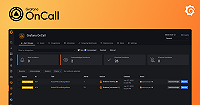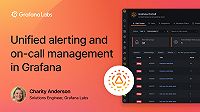Caution
As of 2025-03-11, Grafana OnCall OSS has entered maintenance mode, and will be archived on 2026-03-24. No further feature development will occur; however, we will still provide fixes for critical bugs and for valid CVEs with a CVSS score of 7.0 or higher. For more information, refer to our blog post.
Important: This documentation is about an older version. It's relevant only to the release noted, many of the features and functions have been updated or replaced. Please view the current version.
Configure and manage integrations
Integrations with Grafana OnCall help to ensure effective alert handling and efficiency notification routing. You can configure and manage each integrations settings to meet the needs of the teams that use it. This guide provides an overview on how to configure, customize and manage your integrations.
You can manage or view your integrations current configuration at any time in the Integrations tab of Grafana OnCall.
Connect an integration
To integrate Grafana OnCall with your chosen tools, follow these steps:
- Navigate to the Integrations tab in Grafana OnCall, and click + New integration.
- Select your desired integration type from the list of available integrations. If your desired integration is not listed, select Webhook.
- Provide a title and a description for your integration, assign it to a team, and click Create Integration.
- The Integration page will open, displaying details about the Integration. The provided HTTP Endpoint URL can be used to send events from an external monitoring system. Click the How to connect link for additional information.
- Configure your tool to send alerts to Grafana OnCall.
- Click Send demo alert to send a test alert to Grafana OnCall.
Customize the integration
Explore ways to customize the behavior of your alerts from a specific integration:
- Customize alerting grouping, auto-resolution, and auto-acknowledge templates to tailor the alert behavior for your team.
- Modify Appearance templates to customize how alert groups are displayed in various parts of Grafana OnCall, such as the UI, phone and SMS, email, notifications, etc.
- Add routes to your integration to direct alerts to different users and teams based on labels or other data.
- Connect your escalation chains to routes to ensure the right people are notified at the right time.
- Send demo alerts to an integration to validate that routes, templates, and escalations are functioning as expected. Consider using
Debug Maintenance modeto avoid sending real notifications to your team.
For detailed instructions, refer to:
Manage Maintenance Mode
Maintenance Mode is useful when performing scheduled maintenance or updates on your infrastructure, which may trigger false alarms. There are two modes:
- Debug - Test routing and escalations without real notifications. Alerts will be processed as usual, but no notifications will be sent to users.
- Maintenance - Consolidate alerts into one during infrastructure work.
To manage Maintenance Mode:
- Go to the Integration page and click Three dots.
- Select Start Maintenance Mode.
- Choose Debug or Maintenance mode.
- Set the Duration of Maintenance Mode.
- Click Start.
- To stop maintenance mode before its end, click Three dots and select Stop Maintenance Mode.
Heartbeat Monitoring
OnCall heartbeat functions as a health check for alert group monitoring. You can configure your monitoring to regularly send alerts to the heartbeat endpoint. If OnCall doesn’t receive one of these alerts, it will create a new alert group and escalate it.
To configure Heartbeat Monitoring:
- Go to the Integration page and click Three dots.
- Select Heartbeat Settings.
- Set Heartbeat interval.
- Copy the Endpoint into your monitoring system.
If you need to disable heartbeat monitoring on an integration, use the Reset button to revert it to the inactive state. To restart heartbeat monitoring, send a request to the Endpoint.
Refer to a specific integration’s documentation for more detailed instructions.
Manage and edit an integration
Manage your existing integrations by navigating to the Integrations tab in Grafana OnCall and selecting the integration you want to manage.
To edit the name of an integration:
- Navigate to the Integrations tab, select an integration from the list of enabled integrations.
- Click the three dots next to the integration name and select Integration settings.
- Provide a new name, description, and team, and click Save.
Explore available integrations
Specific guidance and configuration options for each integration are available at Integration references.



